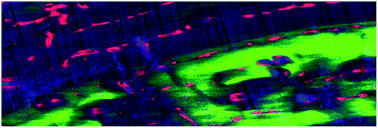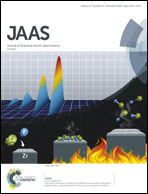Morphological and chemical evidence for cyclic bone growth in a fossil hyaena†
Abstract
Trace element inventories are known to correlate with specific histological structures in bone, reflecting organismal physiology and life histories. By studying trace elements in fossilised bone, particularly in individuals with cyclic bone growth (alternating fast/slow bone deposition), we can improve our understanding of the physiology of extinct organisms. In this study we present the first direct comparison between optical histology (bone tissue identification) and synchrotron-based chemical mapping, quantification, and characterisation of trace elements (biochemistry) within cyclic growth tissues, in this case within bones of a cave hyaena (Crocuta crocuta spelaea). Results show distributions of zinc, an element strongly associated with active ossification and bone growth, correlating with (1) fast-growing tissue of zonal bone (cyclic growth) in an extinct hyaena and (2) secondary osteons (remodelling) in both extant and extinct hyaena. Concentrations and coordination chemistry of zinc within the fossil sample are comparable to those seen in extant bone suggesting that zinc is endogenous to the sample and that the chemistry of bone growth has been preserved for 40 ka. These results demonstrate that the study of trace elements as part of the histochemistry has wide utility for reconstructing growth, diet and other lifestyle factors in archaeological and fossil bone.

- This article is part of the themed collection: JAAS Recent HOT articles


 Please wait while we load your content...
Please wait while we load your content...
